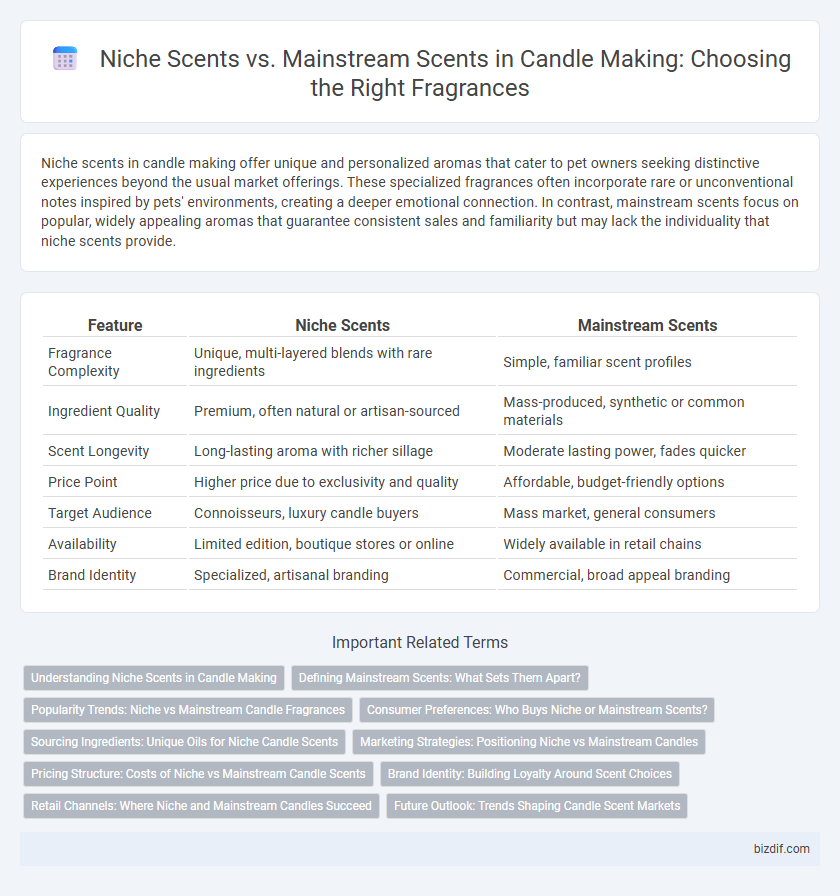Niche scents in candle making offer unique and personalized aromas that cater to pet owners seeking distinctive experiences beyond the usual market offerings. These specialized fragrances often incorporate rare or unconventional notes inspired by pets' environments, creating a deeper emotional connection. In contrast, mainstream scents focus on popular, widely appealing aromas that guarantee consistent sales and familiarity but may lack the individuality that niche scents provide.
Table of Comparison
| Feature | Niche Scents | Mainstream Scents |
|---|---|---|
| Fragrance Complexity | Unique, multi-layered blends with rare ingredients | Simple, familiar scent profiles |
| Ingredient Quality | Premium, often natural or artisan-sourced | Mass-produced, synthetic or common materials |
| Scent Longevity | Long-lasting aroma with richer sillage | Moderate lasting power, fades quicker |
| Price Point | Higher price due to exclusivity and quality | Affordable, budget-friendly options |
| Target Audience | Connoisseurs, luxury candle buyers | Mass market, general consumers |
| Availability | Limited edition, boutique stores or online | Widely available in retail chains |
| Brand Identity | Specialized, artisanal branding | Commercial, broad appeal branding |
Understanding Niche Scents in Candle Making
Niche scents in candle making offer unique and complex fragrance profiles often derived from rare or unconventional ingredients, differentiating them from mainstream scents that tend to be familiar and widely appealing. These specialized fragrances target discerning customers seeking exclusive aromatic experiences, enhancing the candle's perceived value and uniqueness. Mastering niche scents requires a deep understanding of raw materials, precise blending techniques, and market trends to create memorable, artisanal products that stand out in a competitive industry.
Defining Mainstream Scents: What Sets Them Apart?
Mainstream scents in candle making are characterized by their broad appeal and familiar fragrance profiles, such as vanilla, lavender, and fresh linen, which resonate with a wide audience. These scents often dominate retail shelves due to their proven popularity, consistent demand, and versatility in various candle styles. Their commercial success is driven by easily recognizable aromas that evoke comfort and nostalgia, setting them distinctly apart from niche scents that target specific, often more adventurous or unique olfactory preferences.
Popularity Trends: Niche vs Mainstream Candle Fragrances
Niche scents in candle making capture unique, often complex aromas like oud, fig, or seaweed, appealing to consumers seeking personalized and exclusive experiences. Mainstream candle fragrances such as vanilla, lavender, and jasmine dominate sales due to their broad appeal and familiarity. Recent popularity trends highlight a growing consumer shift towards niche scents driven by a desire for individuality, while mainstream fragrances continue to secure mass-market success through consistent demand.
Consumer Preferences: Who Buys Niche or Mainstream Scents?
Consumers who prefer niche scents in candle making tend to seek unique, artisan fragrances that offer personalized and rare aromatic experiences, often favoring high-quality, small-batch products. Mainstream scents attract buyers looking for familiar, widely appealing aromas that evoke comfort and nostalgia, typically available through mass-market brands. Market data reveals that niche scent buyers are often dedicated enthusiasts or gift purchasers, while mainstream scent consumers prioritize accessibility and consistent sensory appeal.
Sourcing Ingredients: Unique Oils for Niche Candle Scents
Sourcing ingredients for niche candle scents involves procuring rare and exotic essential oils such as oud, blue lotus, or yuzu, which provide distinctive aromatic profiles not commonly found in mainstream options like lavender or vanilla. These unique oils often come from specific regions and require sustainable, ethical harvesting practices to maintain fragrance integrity and environmental responsibility. The complexity and originality of sourcing rare botanical extracts elevate the sensory experience and market value of niche candles.
Marketing Strategies: Positioning Niche vs Mainstream Candles
Marketing strategies for niche candle scents emphasize uniqueness and exclusivity, targeting consumers seeking personalized or artisanal fragrances with higher perceived value. Mainstream candle scents capitalize on broad appeal, leveraging familiar, popular aromas and mass distribution channels to maximize sales volume. Positioning niche candles often involves storytelling, limited editions, and premium pricing, while mainstream candles focus on brand recognition, consistency, and accessibility.
Pricing Structure: Costs of Niche vs Mainstream Candle Scents
Niche candle scents often command higher prices due to the use of rare, natural ingredients and limited production runs, which increase manufacturing costs. Mainstream scents benefit from economies of scale, allowing mass production that reduces ingredient and distribution expenses, resulting in more affordable pricing for consumers. The premium pricing of niche scents reflects their exclusivity and artisanal craftsmanship compared to the standardized formulations of mainstream candle fragrances.
Brand Identity: Building Loyalty Around Scent Choices
Niche scents in candle making emphasize unique, carefully crafted fragrance profiles that align closely with a brand's identity, attracting discerning customers seeking exclusivity and personalization. Mainstream scents cater to broader audiences with familiar, widely appealing aromas, fostering immediate recognition and accessibility. Building brand loyalty hinges on consistent scent choices that resonate emotionally with target customers, differentiating the brand through distinctive olfactory experiences.
Retail Channels: Where Niche and Mainstream Candles Succeed
Niche candle scents thrive in boutique stores, artisan markets, and online platforms where unique fragrances attract discerning customers seeking exclusive experiences. Mainstream scents perform well in large retail chains, supermarkets, and mass-market e-commerce sites due to their broad appeal and familiar aroma profiles. Retailers targeting niche markets benefit from personalized packaging and storytelling, while mainstream channels capitalize on volume sales and brand recognition.
Future Outlook: Trends Shaping Candle Scent Markets
Niche candle scents are gaining traction as consumers increasingly seek unique and personalized fragrance experiences, driving innovation in botanical, exotic, and artisanal blends. Mainstream scents continue to perform well due to their broad appeal, with classic aromas like vanilla, lavender, and sandalwood maintaining strong market presence. The future candle scent market will likely see a blended approach, combining niche creativity with mainstream accessibility to capture diverse consumer preferences and sustain growth.
Niche scents vs Mainstream scents Infographic

 bizdif.com
bizdif.com